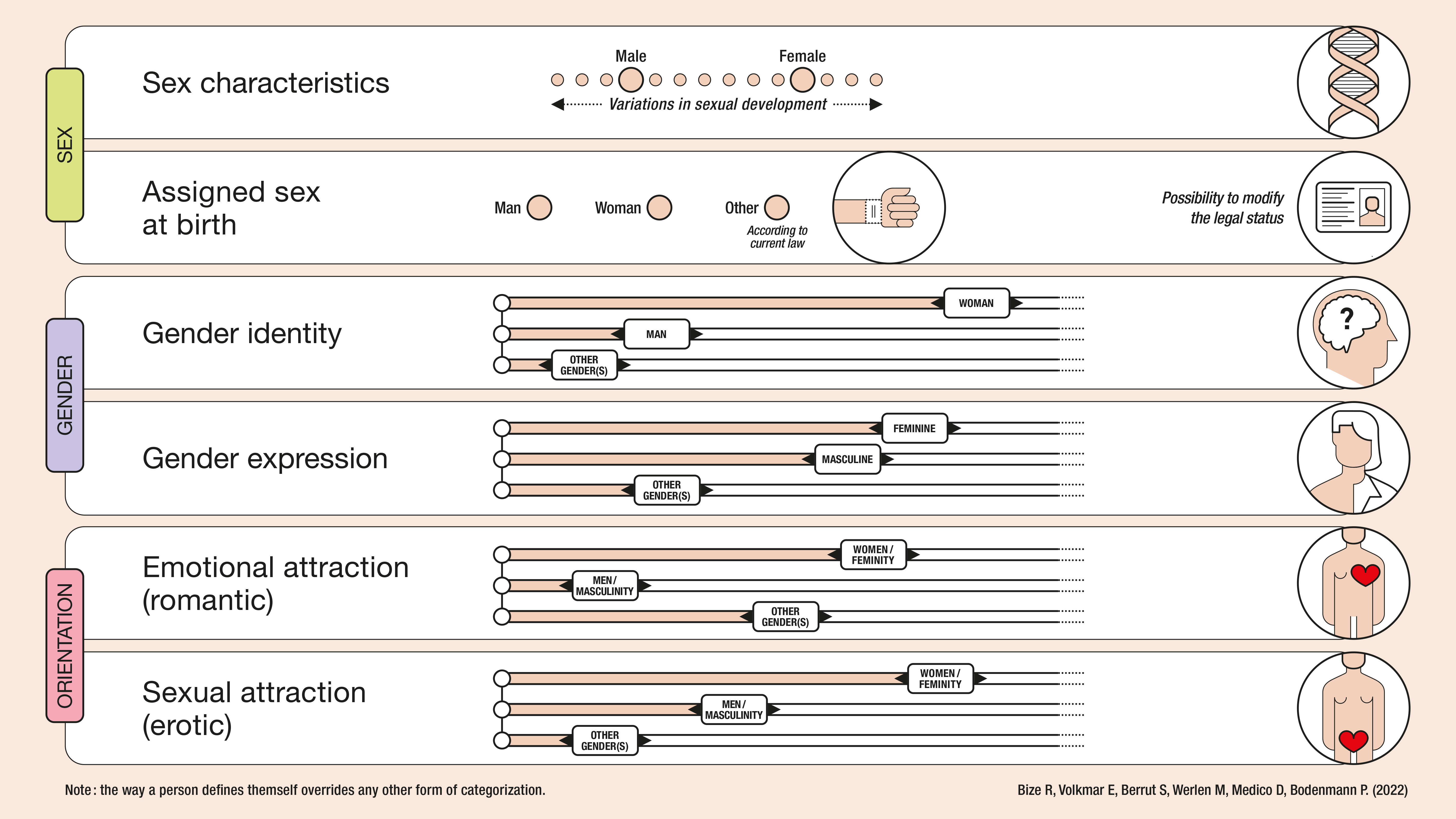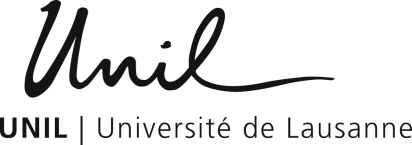Definitions
Definition of the Canadian Institutes of Health Research
Sex refers to a set of biological attributes in humans and animals. It is primarily associated with physical and physiological features including chromosomes, gene expression, hormone levels and function, and reproductive/sexual anatomy.
Sex is usually categorized as female or male but there is variation in the biological attributes that comprise sex and how those attributes are expressed.
Definition of the Canadian Institutes of Health Research
Gender refers to the socially constructed roles, behaviours, expressions and identities of girls, women, boys, men, and gender diverse people. It influences how people perceive themselves and each other, how they act and interact, and the distribution of power and resources in society.
Gender is usually conceptualized as a binary (girl/woman and boy/man) yet there is considerable diversity in how individuals and groups understand, experience, and express it.
SOGIESC is an acronym for sexual orientation (SO), gender identity and gender expression (GIE) and sex characteristics (SC). Unlike the more rigid and labeling LGBTI categorization, the « SOGIESC diversity » concept encompasses the complex realities of all individuals (see the schematic representation below). Some subgroups within the SOGIESC diversity are exposed to stigma and discrimination because they depart from restrictive sex and gender norms. This frequently results in specific health care and public health needs.
Sexual orientation
Sexual orientation is a multidimensional concept that refers to the gender(s) to which a person is romantically or sexually attracted. People may be stigmatized or discriminated against because of their sexual orientation and are frequently targeted because they diverge from the gender norm of heterosexuality, or the norm to be masculine for a man and feminine for a woman.
Gender identity
The deep inner feeling of being a man, a woman, in between, or neither. It can be congruent or not with the sex assigned at birth.
Gender expression
The adoption of behaviors, attributes, or roles that are socially defined as feminine, masculine, androgynous, or other (according to the prevailing norms in a given society at a given time). It is therefore fluid and does not necessarily correspond to what is expected based on the person's gender identity or sex assigned at birth.
Sex characteristics
Primary and secondary biological and physiological characteristics, including chromosomal, gonadal, hormonal and genital characteristics that cause a person to be considered medically female, male or with a variation of sex development.
Sex assigned at birth
After the sex characteristics have been established at birth (usually based on external genitalia), the child is legally assigned Female or Male at the civil status office within 72 hours. Since 01.01.2022, this assignment can be changed in Switzerland on simple request and without medical requirements to a registrar. Until the age of 16, the parents' consent is mandatory. To date, Switzerland does not have a third option (X for other or undetermined).
Schematic representation of SOGIESC diversity [1], with the courtesy of Dr R. Bize, Unisanté, Lausanne

[1]Bize R., Berrut S., Volkmar E., Medico D., Werlen M., Aegerter A., Wahlen R., Bodenmann P. Soins de qualité pour les personnes lesbiennes, gays, bisexuelles, transgenres et intersexuées. In : Bodenmann P., Jackson Y., Wolff H. (Dir.) Vulnérabilités, équité et santé. Chêne-Bourg, RMS éditions / Médecine et Hygiène. 2e édition. 2022, pp. 347-360. ISBN:978-2-88049-512-1.
Depending on sources, gender as a concept can be described as having three or four dimensions. Four dimensions usually encompass gender identity, gender relations, gender roles or norms and institutional gender.
When described with three dimensions[1], the last two dimensions situated at a structural level are combined (i.e. gender roles or norms and institutional gender). Three dimensions separate the individual level, the interactional (relational) level and the structural (norms and institutions) level.
- Individual level (or micro level): gender is internalized through construction of selves and identity. Individuals develop a deeply-held inner feeling of their own gender (gender identity). They can choose to express it or another gender through their behavior, manner and appearance along feminine, masculine or non-binary traits (gender expression).
- Interactional level (or meso level): these are interpersonal interactions in various contexts (e.g., couple, workplace, group) that are subject to gendered social norms, with women and men facing different cultural expectations, which limit their choices and actions. Even in a similar social position, women and men are expected to behave differently. For example, the "good parenting norm" does not have the same effect on women and men, because society expects different things from a mother and a father.
- Institutional level (or macro level): these are gender-specific regulations, laws and organizational practices regarding the distribution of material goods and resources. Indeed, most institutions are not gender-neutral (e.g. the difference between maternity and paternity leave).
[1]Adapted from: Risman BJ. Gender as a social structure: Theory wrestling with activism. Gender & society. 2004;18(4):429-50
Definition from the World Health Organization[1]
Intersectionality builds on, and extends, the understanding of how gender power dynamics interact with other power hierarchies of privilege or disadvantage, resulting in inequality and differential health outcomes for different people. These factors include sex, gender, race, ethnicity, age, class, socioeconomic status, religion, language, geographical location, disability status, migration status, gender identity and sexual orientation.
The wheel of power/priviledge [2]
[1] WHO. Questions and answers. Gender and Health. Accessed on June 6th, 2022.
[2] Sex-Gender-Power-Wheel © 2021 by CIHR, adapted from Sylvia Duckworth, Wheel of Power/Privilege is licensed under Attribution 4.0 International
Definition from the Council of Europe[1]
According to the Council of Europe Gender Equality Strategy 2018-2023, gender stereotypes are preconceived social and cultural patterns or ideas whereby women and men are assigned characteristics and roles determined and limited by their sex. Gender stereotyping presents a serious obstacle to the achievement of real gender equality and feeds into gender discrimination. Such stereotyping can limit the development of the natural talents and abilities of girls and boys, women and men, their educational and professional preferences, and experiences, as well as life opportunities in general. Gender stereotypes both result from and are the cause of deeply engrained attitudes, values, norms, and prejudices. They are used to justify and maintain the historical power relations of men over women, as well as sexist [homophobic and transphobic][2] attitudes, which are holding back the advancement of gender equality.
From gender stereotypes to gender discrimination [3]
In a medical consultation, the social and individual representations of health professionals in relation to the gender of patients are unconsciously manifested. Implicit associations are made through an unconscious and uncontrollable process, they are called stereotypes. If implicit associations have an influence (positive or negative) on the attitude towards patients, then this is a gender bias. If the bias leads to a difference in treatment with negative consequences for patients, then this is discrimination.
Distinction between stereotypes, bias, discrimination [4] (reproduced with the courtesy of Dr. M. Dominicé Dao)
Stereotype:
- Categorisation concerning the allegedly typical characteristics of members of a social group.
- This categorization often has a collective character, shared within a social group.
Bias:
- Positive or negative attitude towards the members of a group.
- Usually based on one or more stereotypes.
- Judgement of a person or group without sufficient knowledge.
Discrimination:
- Action whereby members of a given group are treated differently from the rest of the community on the basis of certain criteria or distinctive features.
- This discrimination can be positive or negative, direct or indirect, individual, collective or even institutional.
[1] Council of Europe. Gender Equity Glossary. March 2016. Revised January 2022. Page 12, accessed on June 6th, 2022.
[2] Addition by the authors of the core curriculum.
[3] FitzGerald C., Hurst S. Implicit bias in healthcare professionals: a systematic review. BMC Med Ethics 18, 19 (2017). https://doi.org/10.1186/s12910-017-0179-8
[4] Dominicé Dao M. Préjugés? Pas dans ma pratique! Prim Hosp Care Med Int Gen. 2018;18(14):250-253. doi: 10.4414/phc-f.2018.01767
Starting in the early years of 21 century, interest in the differences between women's and men’s health grew giving rise to the new discipline of gender medicine [1]. Gender-specific medicine was defined as the study of how diseases differ between men and women in terms of prevention, clinical signs, therapeutic approach, prognosis, psychological and social impact [2]. Gender-specific medicine focusses the attention and efforts of the scientific community on understanding the differences of pathophysiology, clinical signs, prevention and treatment of diseases equally represented in men and women.
The World Health Organization defines gender medicine as the study of how (sex-based) biological and (gender-based) socioeconomic and cultural differences influence an individual’s health[3]. This includes interactions of the patients with the health care system and vice versa. Gender medicine addresses these topics in women, men, and gender diverse persons (Regitz-Zagrosek, Gebhard, Nature RC, 2022, in press).
[1] Legato M.J. Beyond women's health the new discipline of gender-specific medicine. Med Clin North Am. 2003 Sep;87(5):917-37, vii. doi: 10.1016/s0025-7125(03)00063-4.
[2] Baggio, G., Corsini, A., Floreani, A., Giannini, S. & Zagonel, V. Gender medicine: a task for the third millennium. Clin Chem Lab Med 51, 713-727, doi:10.1515/cclm-2012-0849 (2013)
[3] World Health Organisation. Gender and health: overview and WHO's role. Accessed on September 5, 2022.
Definition from the United NationWomen [1]
Mainstreaming a gender perspective is the process of assessing the implications for women, men [and gender diverse persons][2] of any planned action, including legislation, policies or programs, in any area and at all levels. It is a strategy for making the concerns and experiences of women as well as of men [and gender diverse persons] an integral part of the design, implementation, monitoring and evaluation of policies and programs in all political, economic and societal spheres, so that women and men [and gender diverse persons] benefit equally, and inequality is not perpetuated. The ultimate goal of mainstreaming is to achieve true gender equality.
[1] United Nation Women. Gender mainstreaming: REPORT OF THE ECONOMIC AND SOCIAL COUNCIL FOR 1997. Accessed on 22 June 2022.
[2] Addition by the authors of the core curriculum.















